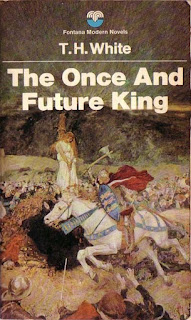Time to reflect on this year’s A to Z Challenge, theme: the Arthurian legend!
 |
| Public Domain |
I have to say, it has been quieter than last year and the year before, mainly because I only visited the blogs of those who visited mine. I have had a lot of family commitments and work catch-up time when I wasn’t with my family. I just couldn’t bring myself to wade through a whole lot of other blogs I hadn’t seen, especially because on the A to Z site it has been a lot harder to find anything that interested me since they went from daily blurbs by bloggers to spreadsheets. I did send a polite email inquiry last year, but got no reply.
But quantity this year was made up for by the quality of those bloggers who did visit - thanks, guys! You rock!
I almost didn’t sign up this year, but decided to have at least one more go because it gave me the excuse to write something every day. I don’t regret it - the Arthurian legend is something I care about very much, and it was fun, not only writing about it and getting responses, but thinking about parts of it that I hadn’t considered before.
I will - hopefully! - be writing a couple of posts a week after this, on my regular themes. I have plenty to talk about - review books I’m reading, some rereads of comfort books, delightful discoveries of books I haven’t seen in years, the CBCA shortlisted books, the Hugo Awards ...
I’d like to get on with my own writing, though - I do have a work in progress and some stuff for which to check out markets.
Before I depart, I have a couple of bits of - good - writing news to share with you.
 |
| This is me, in a very good mood! |
My short story, “Red Sky At Morning”, has been accepted for the anthology Oz Is Burning! This is a themed SF/F anthology about the bushfires we had here last(Down Under) summer. A friend who knew about it told me it was taking submissions - she has a story in it too. There will be more about this closer to the time, when there is a cover reveal. Right now, I do have the Table Of Contents, and I was amazed at the names I saw in it! I am actually in an anthology with the likes of Jack Dann! Lucy Sussex! And many more you may recognise. But I’ll give this a post of its own.
The other bit of good news was from the NSW School Magazine. I should explain the background first. This publication has been around for over a hundred years. I might even have read it when I was a child. Schools buy it for reading in class. Kids love it. There have been some very big names writing for it.
Over the years it has been a wonderful market for me. I used to email to ask if they were interested in a particular theme. If the editor said yes, I’d research and write an article. As long as the writing was good, they would buy it. Only once did they reject an article, when the regular editor was away, and then they still bought it after a rewrite.
So, a couple of years ago, I did the usual and submitted three articles. After waiting for months I emailed to inquire and got a reply that said something like, “Oh, didn’t we tell you? We have gone to themed issues now.”
No, they hadn’t told me. But I asked if they might consider the articles for the themed issues. One of them was published early - they had, after all, paid for it already(back then they paid on acceptance). It was fitted into a science themed issue, as it was about an astronaut, John Glenn. Another, about the Eugowra bushranger robbery, was found a place in a history issue.
After they had done a couple of reprints of my old articles they liked, there was just one left to consider: my article about Apollo 8. Thing is, Apollo 8 happened in 1968. My hope was that it would be accepted and published by the end of 2018, the 50th anniversary, right?
But they had gone to themed issues by then. They did have an issue on the theme of Voyages planned, so I asked to have it considered for that. Okay, they agreed, and I waited some more months. Recently, I visited the web site to see what was going on. I couldn’t find anything about forthcoming themes, so I emailed.
Apparently they had stopped doing themed issues. You could submit directly on the web site, as many publications are now doing.
I resubmitted. They have accepted it. It may still be a while, but the editor assured me they had all loved it, so publication is very likely.
Two years, but it’s finally there! I am very happy.
I will go away now and look again for a market for my Gawain and the Green Knight novella. Meanwhile, if you want a copy in ebook email me and ask. I can send it to you in PDF or ePub. I think you can convert PDF to mobi.













